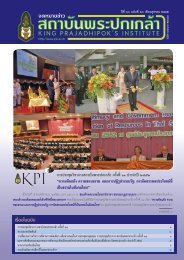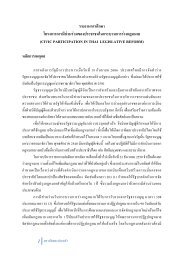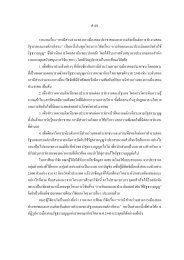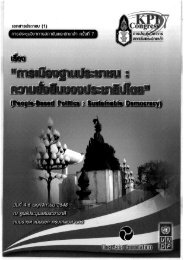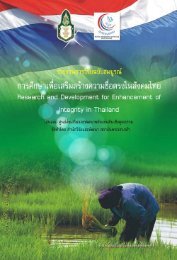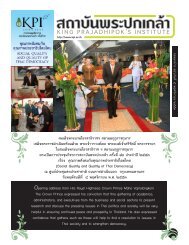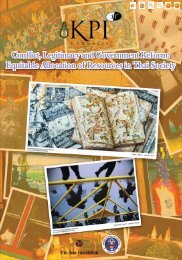SUFFiciENcy EcONOMy ANd GRASSROOtS DEvElOPMENt
SUFFiciENcy EcONOMy ANd GRASSROOtS DEvElOPMENt
SUFFiciENcy EcONOMy ANd GRASSROOtS DEvElOPMENt
Create successful ePaper yourself
Turn your PDF publications into a flip-book with our unique Google optimized e-Paper software.
220<br />
The Meaning of Sufficiency Economy <br />
International Conference<br />
The ritual cycle, together with the agricultural cycle, gave meaning to most<br />
villagers for most of their lives from their birth, through their adolescence, courting,<br />
and marriage and concluding with their ageing and deaths. There were also other<br />
influences on their lives that emanated from the Thai nation-state that the village had<br />
long since been incorporated into and the economy linked to markets that extended<br />
even beyond Thailand.<br />
<br />
VILLAGERS EMBRACE CAPITALISM<br />
The Village on the Eve of ‘Development’<br />
The village in the early 1960s was not totally self-sufficient. Some cash was<br />
generated through the sale of rice, a few other agricultural and craft products and<br />
through some wage labor outside of the village. Nonetheless, total cash income per<br />
household in 1963 was only about 3,000 baht, then equivalent to US$150. Cash was<br />
used for such thing as metal tools, corrugated iron roofing, health care, and<br />
especially support of the wat and the monks and novices.<br />
The one significant village enterprise was blacksmithing. Until the mid-1960s<br />
there were at least four blacksmiths in the village. The main cash crops, while still<br />
bringing very small amounts of income to villagers, were khao cao, the dominant<br />
varietal of rice in Thailand but different from the glutinous rice consumed by<br />
villagers, tobacco, and kenaf, a jute-like fiber crop. Rice was raised in paddy land<br />
while tobacco and kenaf were raised on land that was too high for paddy cultivation. <br />
By the 1960s a new economic practice was becoming significant especially for<br />
village men – namely, non-agricultural work for extended periods especially in<br />
Bangkok. In a survey carried out in 1963 I found that about 30% of men over the<br />
age of 20 had spent some months or even years working in jobs in Bangkok. While<br />
most who engaged in migrant work in the 1960s remitted or saved little money,<br />
some became the first entrepreneurs of the village. One young man had earned<br />
enough from work for six years in a Chinese noodle factory in Bangkok to open the<br />
only shop and the only rice mill in the village.<br />
First shop and rice mill in Bãn Nông Tün, established by same man <br />
(photos by Jane Keyes)<br />
This young man had been able to save sufficient money for his investment<br />
during his six years work in a Sino-Thai noodle factory in Bangkok because he<br />
knew how to ot thon, to withstand desire for immediate gratification. His ability had<br />
been cultivated during his six years as a novice and a monk. In short, he embodied a<br />
Buddhist version of the Protestant Ethic 6 . This ability to ot thon was also<br />
6<br />
I developed this interpretation further in another paper (Keyes 1983); also see Keyes (1990<br />
and 1991b).



